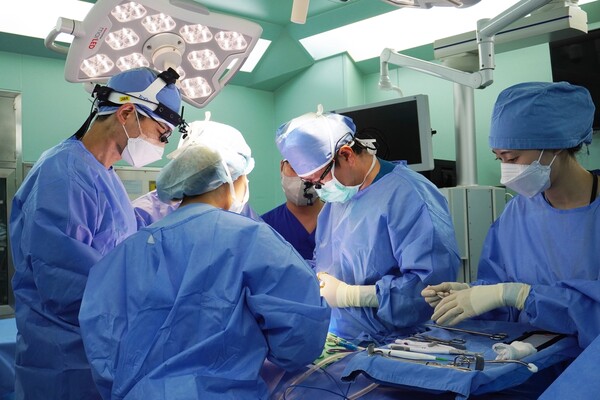A team of researchers led by Professor Kim Sung-won of the Catholic University of Korea College of Medicine has successfully implanted the "world's first" customized and 3D-bioprinted artificial trachea based on another person's adult stem cells for a patient with an intractable tracheal defect, Catholic Medical Center said.

The team performed the transplantation in August last year and confirmed its successful engraftment recently after six months of follow-up observation.
The cutting-edge regenerative clinical study was led by the Catholic University of Korea St. Mary's Hospital (Professors Kim Sung-won and Park Sung-hwa of the ENT Department and Professor Bae Ja-sung of the Thyroid and Endocrine Surgery Department) in collaboration with Gachon University (Professor Lee Jin-woo Lee) and T&R Biofab (Dr. Kim In-ho). The Catholic University of Korea Incheon St. Mary's Hospital (Professor Nam In-chul of the ENP Department) and POSTECH (Professor Cho Dong-woo) also participated in the study.
This study, conducted for about 20 years, is the first clinical application of adult stem cell-based patient-customized 3D-bioprinted artificial trachea in clinical practice.
Catholic Medical Center said it is also the "world's first" research, development, and clinical trial in which real adult stem/chondrocyte cells were bio-printed through a strict biopharmaceutical GMP cell production process at the Biopharmaceutical GMP Cell Production Laboratory of Seoul St. Mary's Hospital, Catholic Cell Therapy Division of the Archdiocese of Seoul, and transplanted into patients with intractable tracheal defects for treatment.
Closely related to breathing, the trachea is the uppermost part of the airway. It is a tube-like structure that runs from the throat to the chest and allows air to flow in and out. It also serves as a pathway for bronchial secretions to drain. The trachea can be narrowed or damaged by head and neck cancers, including thyroid cancer, congenital anomalies, and trauma.
Patients who have undergone intubation and tracheotomy for intensive care are also prone to tracheal stenosis, and tracheal defects can occur when the trachea is removed during head and neck cancer surgery.
The existing treatment methods for this disease are complex and risky and cannot fully restore the trachea to its previous state. So, there is an urgent need for a reconstructive method that can reconstruct the tracheal skeletal structure and maintain tracheal function at the same time. However, this is an intractable disease with no alternative treatment to date.
"3D Bioprinting Respiratory Airway Regeneration Using Human Neural Stem Cell-Based Bioink for Clinical Practical Application," is the world's first advanced bio fusion product that uses biopolymers to create a human organ simulator with similar appearance to simulate surgery, Catholic Medical Center said.
Unlike conventional 3D printing, which creates prosthetic devices, such as dentures or hearing aids, and produces medical devices for human transplantation, 3D bio-printing, which creates activated organs and tissues for transplantation by cell printing living cells similar to the structure of real organs/tissues, has been used to create artificial organs for patient transplantation that did not exist until now.
In this study, human tissues discarded during “nasal inferior turbinate surgery,” a frequently performed procedure for treating nasal congestion, were recycled and used as a source of new functional adult stem cells. Chondrocytes for the regeneration of supernatural bone were isolated and cultured from human cartilage tissue discarded during nasal septum surgery.
The process of clinical transplantation into the human body was made possible by the collaborative efforts of stem cell researchers and biomaterials researchers specializing in the study of adult stem cells, engineers with precise 3D printing processing technology, regulatory science researchers specializing in the clinical application of new advanced biopharmaceuticals, and researchers specializing in GMP processes and quality control of advanced biopharmaceuticals, as well as multidisciplinary collaborative research among otolaryngologists and surgeons who treat and operate on actual patients, as well as the establishment of a collaborative system and shared long-term goals among each research institute.
For the artificial trachea transplantation using allogeneic adult stem cells, both an investigational new drug (IND) approval (March 2021) and an advanced regenerative medicine clinical research approval (January 2022) were obtained from the Ministry of Food and Drug Safety and the “Advanced Regenerative Medicine Clinical Research Support Project” was conducted with the support of the Ministry of Health and Welfare and the Korea Health Industry Promotion Agency under the Act on Safety and Support for Advanced Regenerative Medicine and Advanced Biopharmaceuticals, which was implemented in 2021.
"The success of this transplant is the world's first clinical trial success story of artificial human organ transplantation developed by applying bioprinting precision engineering technology that 3D prints adult stem cells from living human beings,” Professor Kim said. “It has laid the foundation for developing patient-specific 3D bio-printing artificial organ transplantation technology and will play a major role in developing advanced biopharmaceuticals for various intractable diseases."

